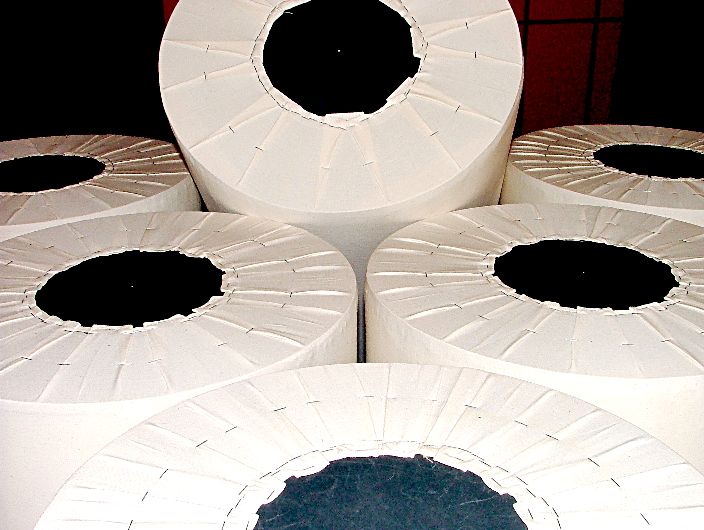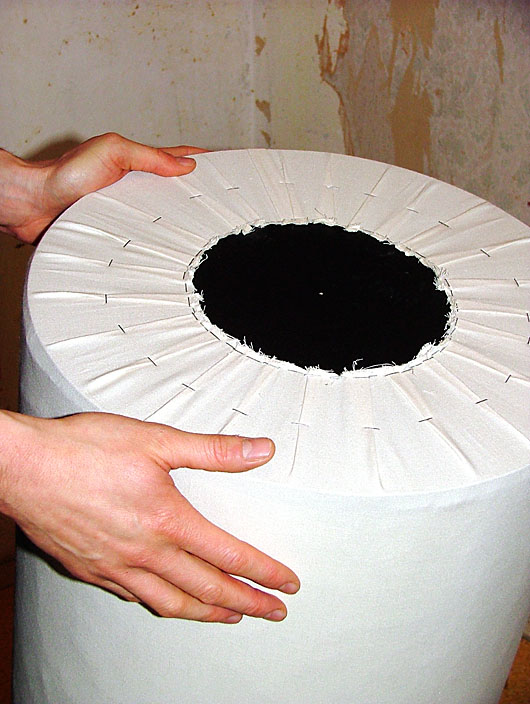Music
and Movies
To demonstrate the effects of the ASC TubeTraps in my
room, I started with "About a Girl," the
opening cut from Nirvana's 1994 release Unplugged in
New York (UNI/DGC Records). When removing the 11-inch
tubes from the first reflections on the front and
side walls, I found the vocal images became clouded
and undistinguishable in location. When I reinstalled
the TubeTraps, the images again became solid and
contained a much more realistic tone. Kurt Cobain's
voice had considerably greater timbre and depth with
the TubeTraps installed.
The TubeTraps treatments are designed to control high-pressure
waves, so I thought, let's give them some waves. On
Van Halen's "Panama" on their album 1984 (Warner
Bros.), I found the bass and drum tracks to be
notably different. The drums, without the use of
corner TubeTraps, were fat and slow. Bass performance
with tube traps had a focused position rather than
just filling the room. As mentioned earlier, the 16-inch
round corner treatments are large and perhaps not for
every room, but the benefits were unmistakably
engaging.
In the original Jurassic Park (Universal - DTS), the
scene where T-Rex makes his escape and quickly
commences to terrorize the kids in the car, the
rumble of the dinosaur's growl was clearly improved.
The low frequency effects were much better controlled
and had improved definition, which made the scene
more chillingly realistic. I use dual subwoofers that
can easily overload a room, but here I found the
information to be very solid. Without treatments, the
bass could become fatiguing and somewhat overwhelming,
lacking any distinguishable definition or source.
How do I know if room treatments will provide sonic
improvements for my listening environment?
The end result of a room treatment is a room that is
void of any echoing effects. It is live and ambient
and displays very controlled bass, yet has no
inherent deadness. If you clap your hands in this
room, it will sound similar to what you'd hear if you
clapped your hands outdoors, in that the quality of
the clapping is live and has a snap or quickness,
with no delayed resonance or decay. This is easily
achieved in an outdoor setting, as there are no
structures for the sound to bounce off of and return
to you. The perfect room would be eminently quiet,
because for each frequency of noise, there is a
cancellation of music in the equal frequencies and
the equal sound pressure level, or SPL. To determine
the condition of your room, walk around the space and
clap your hands. Do you hear resonant echo? Do you
hear slap echo, a condition caused by parallel walls
that are void of structure that would otherwise break
up, absorb and often diffuse such bouncing waves?
Slap echo can most often be identified by a quick
chirp that follows the handclap. Do you have TVs and
other items between your speakers that can interrupt
and affect your soundstage? Are your speakers close
to one wall and either not close to another, or there
is another room opening to the side of the second
speaker? These are all typical conditions we
encounter in what I describe as normal listening
environments, which describes 95 percent of the
settings for home A/V systems. All of these
conditions significantly degrade your sound system's
performance.
Okay, I have determined that I have some of these
conditions - how much of this stuff that you're
talking about do I need, how much is this going to
cost me, and what should I expect to hear?
The engineers at ASC are very good about assisting
you in determining which products will best control
the conditions in your room. You can also check with
your retailer to see whether they can help provide
you with the technical information you will need to
properly treat your room.
I will share a couple of scenarios, and provide you
with my recommendations for the best and most
effective solutions. Please understand that these are
only generic recommendations intended to give you a
baseline for understanding which products you might
need, what treating your room acoustically is going
to cost you, and what results you should reasonably
expect to achieve.
The first condition that needs to be addressed is
controlling echo. There has been a trend of late to
create large rooms in our homes, sometimes combining
a two living rooms into one larger room, often called
a "great-room." This can be particularly
troublesome because these rooms are very big with
very large walls, often with vaulted ceilings. If
this is your situation, you will definitely want to
consult with the engineers at ASC. This condition can
be extremely hard to remedy sonically. Echo is the
most degrading condition in any room. Before we test
and treat this condition, let's look at a package
that will benefit absolutely every room. Once we
understand this basic treatment package, we can
assess the need for additional acoustical treatments.
As a minimum, I recommend four 11-inch round
TubeTraps, one at each of the first reflections on
the side and front walls. These will control most
troublesome early reflections, providing large
improvement to your soundstage. You will be
absolutely amazed at the noticeable lift in sound
quality that this will provide in nearly all rooms.
The price of the 11-inch diameter, four-foot-high
rounds is $328 each. You could consider half-round
TubeTraps at $248 if space is a concern, but you
would sacrifice performance. The half rounds tend to
look a little more planned and sleek in your room,
but the performance of the full rounds is superior
and will provide you with better control. Once you
have treated the first reflections, it is time to
ascertain whether you have slap echo. As you walk
around your room and clap, you will likely hear echo
in select areas. If that's the case, you will want to
consider wall panels. These are designed to diffuse
sound waves and work very well for this application.
Wall panels measure eight inches wide by four feet
tall and cost $398 for a package of eight. Wall
panels can also be purchased in smaller or greater
quantities if you need additional treatment. To make
the most effective use of the panels, I suggest that
you position the panels on the walls in the specific
areas you determined you were experiencing the slap
echo. You'll want to mount the panels so that they
are spaced one panel width apart on each of the side
walls, staggered by one panel width on the opposite
walls. If you were to shine a light from a panel on
one side wall to the other side, you would hit a
space between the panels in the parallel pattern on
the other wall. You might call this an offset pattern.
This will control slap echo very well and allow for
little to no cancellation in your reproduction.
There are relatively few rooms that don't suffer from
large standing waves. This is a condition that will
cloud your bass, making it soft and robbing it of
dramatic impact. Treating this condition is not cheap
and takes up considerable room. To treat this, I
would suggest 16-inch diameter, four-foot high rounds
in each corner of your room. As a minimum, you can
put one in each of the corners behind your speakers,
but treating each of the four corners is preferred.
The 16-inch rounds cost $498 each per treatment. As
mentioned before, these are generic conditions, but
these examples are intended to provide you with an
understanding of what treating your room will cost.
With the above treatment set, you could expect to
experience large improvements in every area of
performance. You will likely experience a
considerably more palpable midrange and greatly
improved vocal timbre. Instruments will have greater
depth and greater three-dimensional textures. I would
expect your bass performance to improve dramatically
in definition and focus. Ideally, individual room
conditions will be analyzed separately and optimized
for your specific environment. The above
recommendation is a typical building block to an
ideally-treated room.




